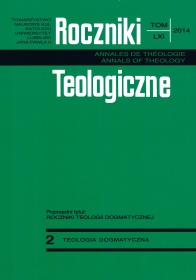Mary as the Icon of Christ − the “New Man”. Via Pulchritudinis in Mariology
Abstract
Mariology that is an academic reflection on the person of the Virgin Mary requires an adequate methodology. The tradition that is many hundreds of years old has worked out various ways of cognition. Besides the dominating logical-rational reflection (via veritatis), there is also the equally legitimate via pulchritudinis. Its significant role in Mariological reflection was pointed to by the recent popes. In the second half of the 20th century an important role of aesthetics in theology was emphasized by Hans Urs von Balthasar. If theology is symbolic, Mariology plays a critical role, as it is with the participation of Mary that God performs the mysteries that He reveals, and it is with Her that He causes them to be perceived. Aesthetic Mariology becomes then a way to cognize the beauty of Christ via a contact with His beauty reflected on the image of Mary’s life. Mary, being an actual person, plays an essential role in the birth of Christ as the “icon of the invisible God”. Maintaining the principle of analogy it may be stated that like Christ is an icon of the invisible God, Mary also is one, being “an icon that gives birth to the Icon”. Mary herself, being a synthesis of the beauty of God’s work, helps us discover the beauty that we can enjoy through Her mediation: becoming a new man by participating in the salvation, which is Christ’s work that creates a new man.
Copyright (c) 2014 Roczniki Teologiczne

This work is licensed under a Creative Commons Attribution-NonCommercial-NoDerivatives 4.0 International License.





